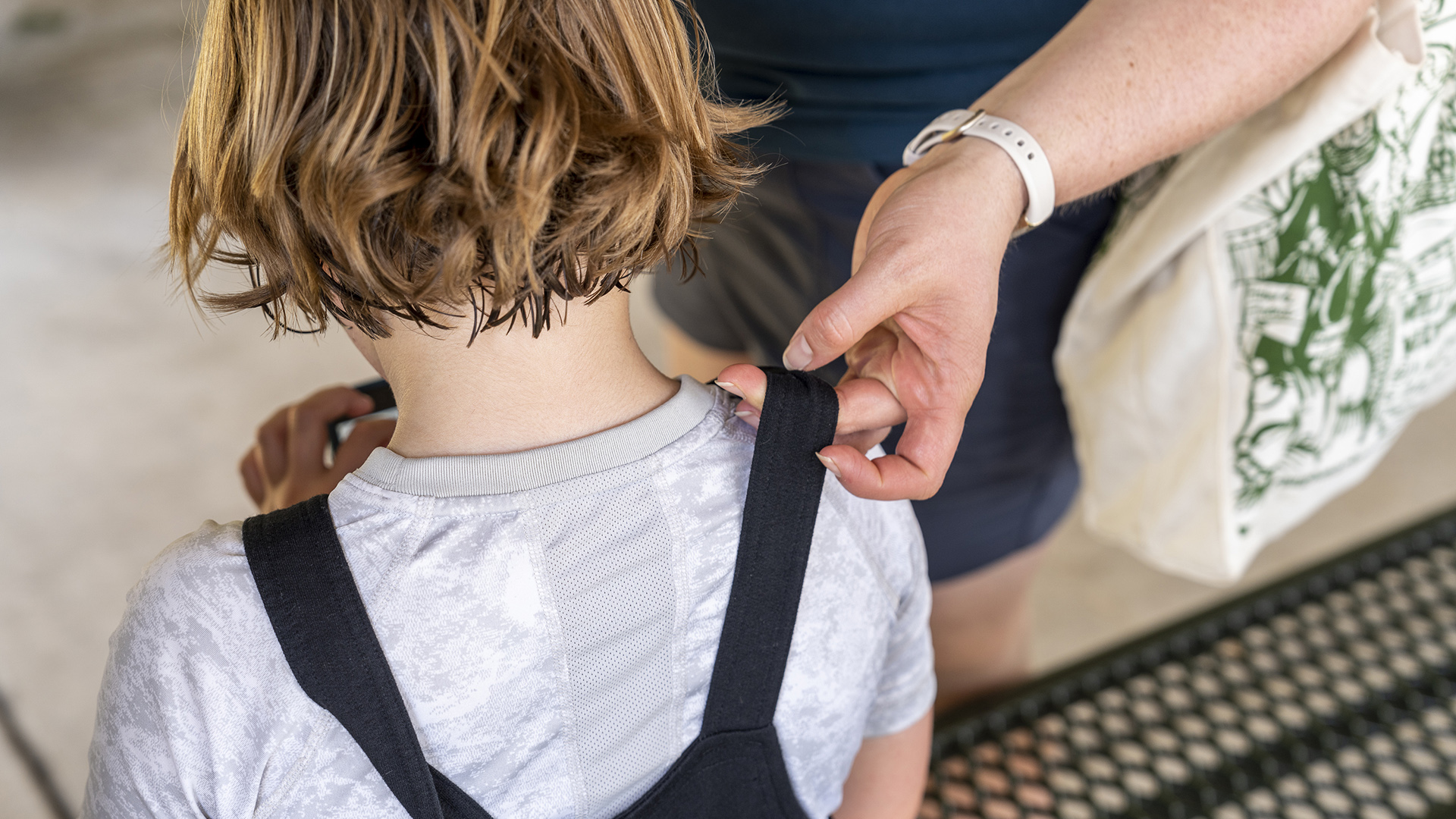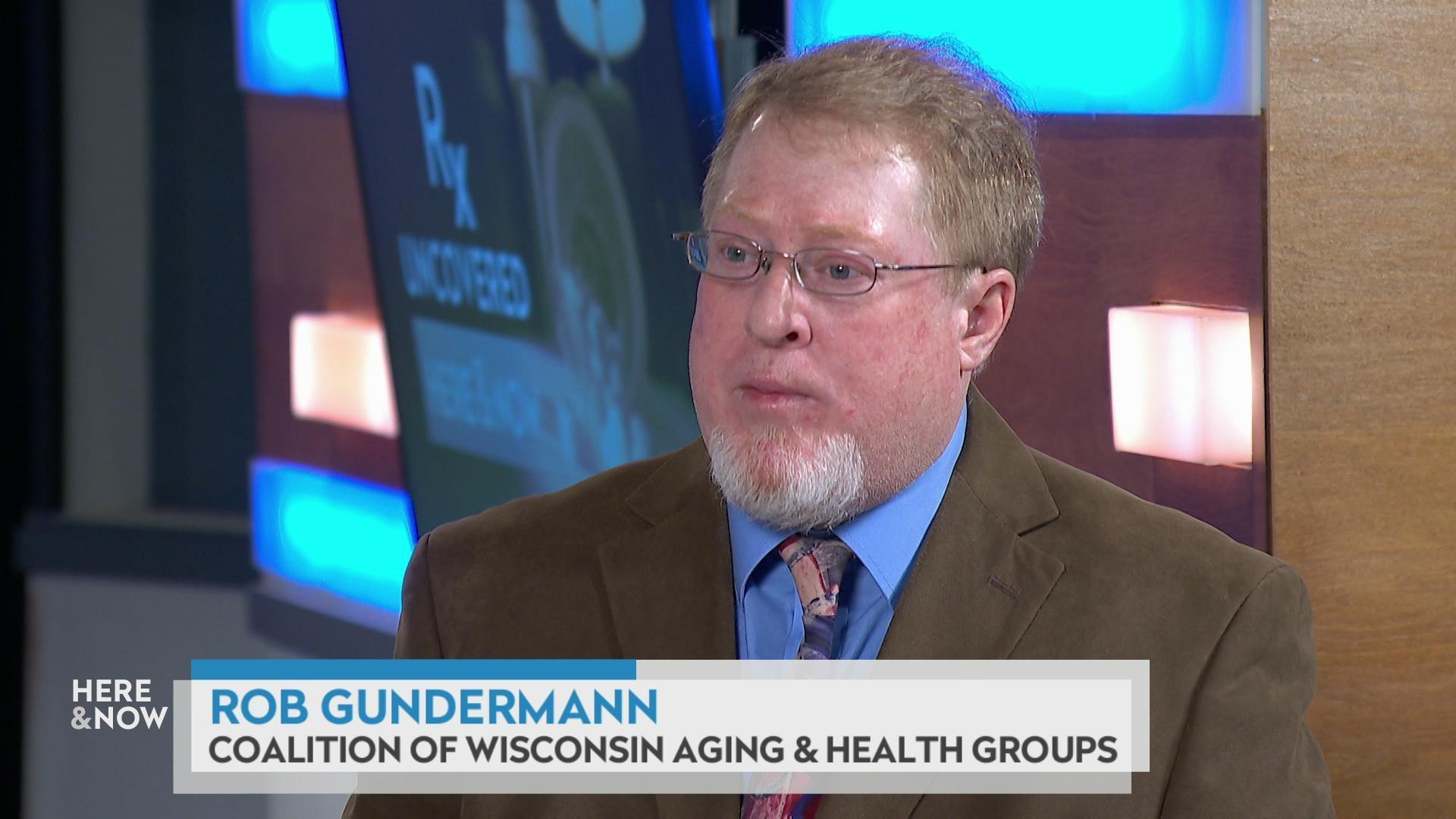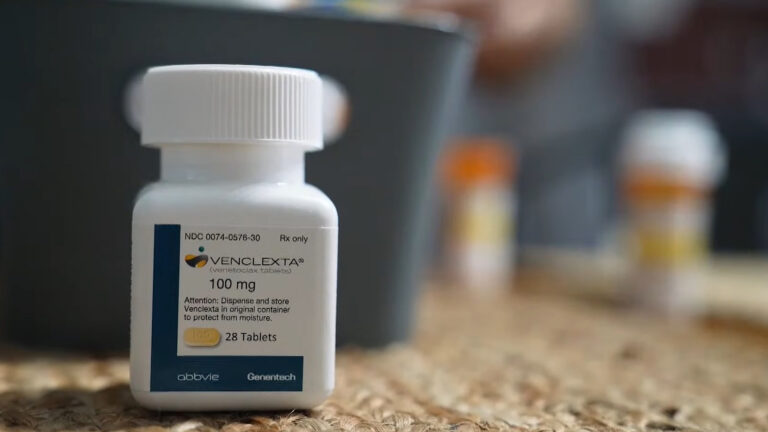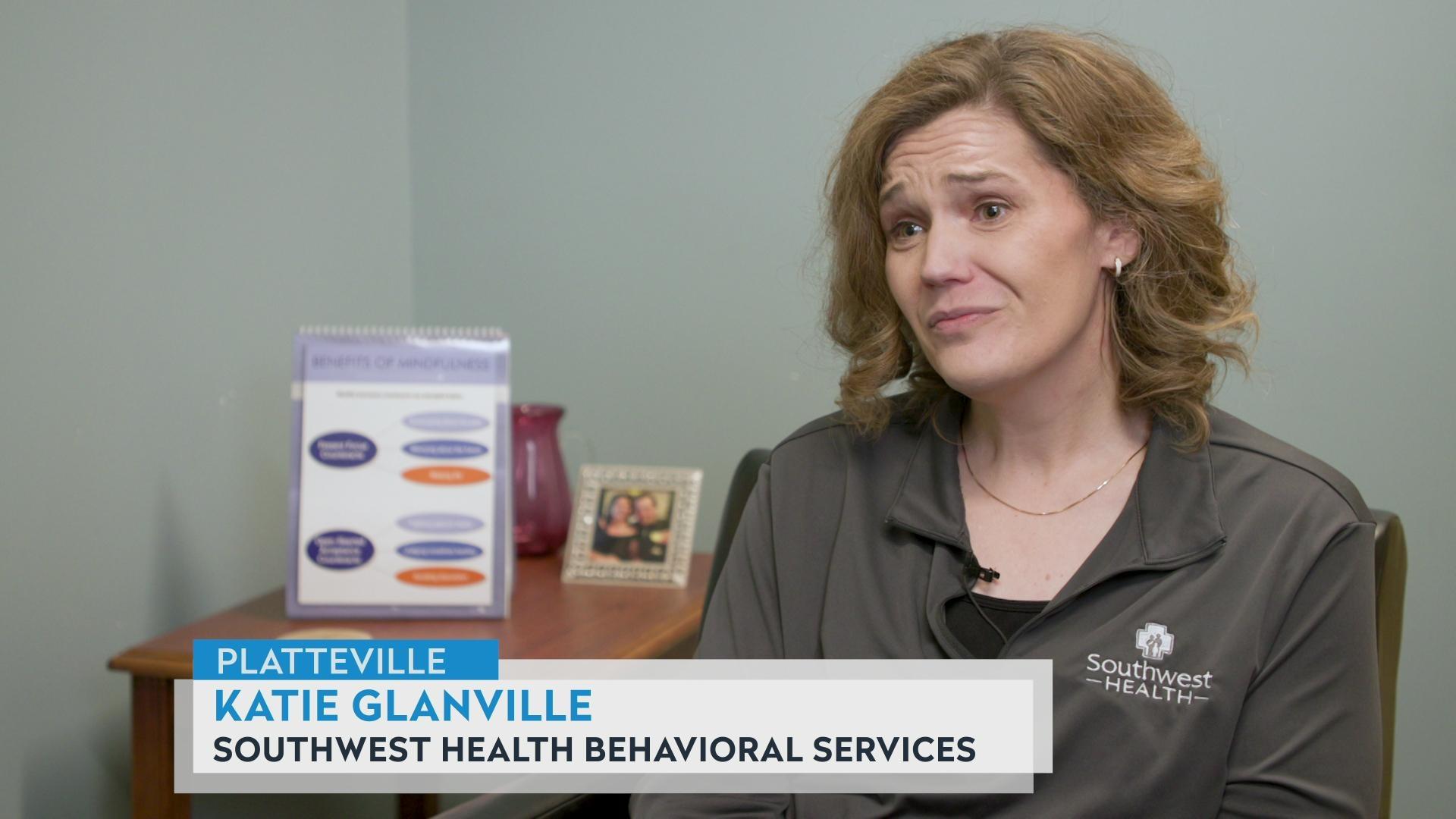What gender-affirming care means for three Wisconsin families
As Republicans weigh legislation that would limit access in Wisconsin, a trio of families share their experience receiving medical care for transgender children at three stages of development.
Wisconsin Watch
October 9, 2023

Six-year-old Sam, a pseudonym, plays at a Wisconsin park on June 24, 2023. Sam is transgender and receiving gender-affirming care — which, until puberty begins, simply involves social support. The family has chosen to remain unidentified because of the harassment trans people and their allies face. (Credit: Sara Stathas for Wisconsin Watch)

This article was first published by Wisconsin Watch.
Six-year-old Sam is nonbinary.
If you ask them to describe themself, they’ll say something like: “I’m neither a boy or a girl.” Sometimes, it’s “I’m both a boy and a girl.”
The words Sam uses have changed as they’ve grown. But what Sam has to say has remained steady: Their gender identity does not align with their sex a doctor assigned at birth based on external anatomy.
Trans people have existed across the globe for millennia, and their identities are natural, normal and healthy variations of human expression. While various counts show the number of American transgender people growing, the population remains tiny, constituting an estimated 1.6 million Americans, or 0.5% of adults and 1.4% of youth ages 13 to 17, according to The Williams Institute at UCLA School of Law, a leading researcher for LGBTQ+ people.
Yet in recent years, transgender people — especially youth — have weathered unprecedented legislative attacks: More than 400 bills targeting trans rights were introduced in 2023 — or more than the combined total of the previous four years — according to an analysis by The Washington Post. The architects of this coordinated movement are conservative and Christian nationalist organizations who also organized opposition to abortion rights.
Bans on gender-affirming care for transgender youth, passed in 21 states, rely on a shared disinformation playbook, which entails false claims about gender dysphoria and false claims about the safety, evidence and practice of gender-affirming care, according to researchers at Yale School of Medicine.
In recent months, Wisconsin’s right-wing politicians and media have echoed that messaging. At the end of September, Assembly Speaker Robin Vos, R-Rochester, and others circulated a proposal that would ban trans youth’s access to gender-affirming care, including puberty blockers.
The lawmakers’ memo uses outdated terminology to falsely claim that almost all transgender youth “detransition” and identify with their birth sex. In fact, a landmark study recently found the opposite: Trans children who socially transition are overwhelmingly likely to still identify as trans five years after.
Democratic Gov. Tony Evers responded on social media that he would veto “any bill that makes Wisconsin a less welcoming, less inclusive, and less safe place” for trans youth.
Gender-affirming care is the only evidence-based treatment for gender dysphoria — a diagnosis for the distress experienced by some whose gender identity conflicts with their sex assigned at birth. It is endorsed by every major medical association in the United States.
Gender-affirming care refers to a process of social, legal and medical steps a trans person may take to live authentically. It is nonlinear and varies by person, as there is no single way to be transgender. Young people must be diagnosed with gender incongruence before they receive any form of medical treatment, which is not recommended until puberty begins.
To document what gender-affirming care looks like for Wisconsin’s transgender youth, Wisconsin Watch spoke with three young trans people and their families. We also reviewed publicly available policies for the state’s two pediatric gender clinics, as well as the clinical guidelines they follow, and interviewed medical providers across the state.
All describe thorough processes with extensive discussions before and throughout treatment, buttressed by research documenting improved mental health outcomes for trans youth who are supported in their identities and able to access desired gender-affirming care.
Only one family, 19-year-old Dan Ratcliff and his mom, Rep. Melissa Ratcliff, D-Cottage Grove, agreed to share their names publicly. This is the first time the mother and son have jointly spoken to the press about Dan’s transition-related care.
Wisconsin Watch is using pseudonyms for the others because of the harassment trans people and their allies face.
“I can’t change the world, but I can change our environment,” said Sam’s dad, Fred. “(I) can be that first ripple in the pond that makes society understand that, hey, we’re not going back to the ’50s. We’re not going back to having to hide. We’re not going back to pretending that it doesn’t exist. We’re not going back to people hurting themselves because they don’t feel like they belong. We’re going to be supportive. We’re going to do this together. And we’re going to make sure that it’s different.”

Sam’s mom adjusts the strap on their jumper at a Wisconsin park on June 24, 2023. At age 3, Sam began telling their parents the label of “girl” did not fit. Sam is a pseudonym. The family has chosen to remain unidentified because of the harassment trans people and their allies face. (Credit: Sara Stathas for Wisconsin Watch)
Sam’s story: ‘Going with the flow’ in a trans childhood
At 3, Sam began telling their family the label of “girl” didn’t fit.
They came home crying from day care whenever friends and teachers implied, in their mom Mary’s words, that Sam’s “gender was limited to just being a girl.”
Mary joined a Facebook group for parents of trans youth and sought out children’s books like “It Feels Good to Be Yourself” and “Jamie is Jamie,” which helped Sam learn about gender identity: all the different ways people can be boys, girls, something in between or totally different.
The books put language to Sam’s experience and made them feel less alone, especially when describing gender-diverse young people throughout history. Across the country, books with LGBTQ+ themes have become the disproportionate target of challenges and bans.
“Having stories about other trans kids and nonbinary kids is really helpful for them to be able to see, ‘I’m not the only one,'” Mary said.
Sam’s parents had already modeled how gender does not limit what a person can like or do. Sam’s dad cooks the family’s meals. Mary played tackle football and works as an engineer.
As Mary put it, “(Sam) has firsthand experience of a mom that pushes the boundaries of what it means to be a woman, but there is such a clear and visceral knowledge in (Sam)’s bones that the label of girl and girl alone does not fit.”
It’s not that the label of “girl,” she said, “wasn’t expansive enough, but the very label did not fit.”
Before Sam’s 4-year-old checkup, Mary sought advice from the pediatrician, writing in a note reviewed by Wisconsin Watch that Sam “has been telling us with whatever language they have had at the time that they are not strictly a girl for over a year.”
At such a young age, Sam didn’t “really understand the significance of pronouns,” Mary wrote, so the family still used she/her, but Mary was “practicing using they/them in writing about (Sam) in anticipation of that change.”
“I absolutely understand that (Sam)’s gender identity may change over time, but I am very certain they are not confused about this and this is who they are right now,” she wrote.

Sam’s family takes a walk together on a nature trail at a Wisconsin park on June 24, 2023. Republicans in 21 states have passed laws banning gender-affirming care for youth. Republican lawmakers have introduced similar legislation in Wisconsin. (Credit: Sara Stathas for Wisconsin Watch)
Sam’s pediatrician referred the family to the Children’s Wisconsin Gender Health Clinic. Children’s Wisconsin and UW Health house the only two health care facilities in the state dedicated to trans youth. Children’s Wisconsin declined an interview, but a handout describes what initial appointments for youth of different ages entail.
Both clinics follow guidelines set by the Endocrine Society and World Professional Association for Transgender Health (WPATH). In a review of existing research, WPATH experts determined that although studies contained “relatively small groups of youth” and varying time frames for follow-up, “this emerging evidence base indicates a general improvement in the lives of transgender adolescents who, following careful assessment, receive medically necessary gender-affirming medical treatment,” and that regret is “low.” Since the standards’ release, new research has strengthened that conclusion.
WPATH guidelines require holistic biopsychosocial evaluations and extensive discussions with young people and their families before and during treatment, recognizing that children grow and change.
At Wisconsin’s clinics, per those guidelines, young trans children like Sam do not receive any medical treatment. Until a child reaches puberty, gender-affirming care may involve only social or psychological components — not medical ones. They might try new pronouns or a new name, change their clothes or hair, or start seeing a therapist.
Sam’s pediatrician had described the clinic’s “huge benefit” as the “resources, connections and education they will be able to provide.”
Their first appointment mostly involved talking, and Mary joked the appointment was more for parent than child. Doctors also shared a packet of information with names of support groups and books and told Mary to keep doing what her family had been doing: supporting Sam as they discovered and expressed themself.
“(Sam) was excited to go see the doctor because it’s like, ‘Hey, this is an OK thing. I’m not totally weird,'” Mary said.
Research shows that trans youth who are accepted and affirmed are safer and happier.
The Trevor Project, which works to end LGBTQ+ youth suicide, found that trans and nonbinary youth who report all or most people respect their pronouns attempt suicide at half the rate of those whose pronouns are ignored. A peer-reviewed study found that trans and nonbinary youth who got to use their chosen name in multiple contexts suffered less depression, suicidal ideation and attempts. Another found that trans youth who socially transitioned before puberty had fewer mental health problems than trans youth who do not socially transition.

Sam, a pseudonym, holds a leaf on a nature trail at a Wisconsin park on June 24, 2023. They dream of being the first kid (and nonbinary) astronaut. (Credit: Sara Stathas for Wisconsin Watch)
Sam visited the gender clinic three years ago and hasn’t returned since, but Mary and Fred have committed themselves to learning, listening and adapting as Sam grows up.
“It was scary when I first talked to (Sam’s) day care about their gender and the struggles they were having with the gender policing from the kids and teachers,” Mary said. “I was nervous that I would do all this and the next day (Sam) would change their mind about gender.”
But that’s one more way the clinic’s approach to gender-affirming care helped her.
“The gender clinic prepared me for the fact that (Sam’s) gender and gender expression were very likely to change as (Sam) began to figure this all out. I was prepared for that to be part of the process and to keep supporting (Sam) through those transitions.”
Right before kindergarten, Sam asked to live as a boy. They wanted a new name, Theo (also a pseudonym), he/him pronouns and use of the boy’s bathroom. Mary called the school and a secretary made the change, so Sam entered school as Theo, without peers knowing Theo had ever been Sam.
At school, they blossomed. They begged to go to school on the weekends. Whenever Mary asked about their favorite part of school, they would shout, “ALL OF IT!”
And about halfway through the year, Theo decided to go back to Sam and use they/them pronouns. So Sam’s family, teachers and classmates adjusted.
“It doesn’t fit anymore? Let’s change it,” Mary said. “Let’s not struggle and feel upset about it or like you don’t fit in your own skin. … Let’s make you comfortable.”
Mary and Fred both described their approach to supporting Sam as “going with the flow,” supporting Sam’s autonomy while communicating openly and honestly.
“As long as we keep that mindset, no matter what else comes, we’re in it to support (Sam) through whatever it is that they need,” Fred said.

Sam, a pseudonym, plays on the playground at a Wisconsin park on June 24, 2023. Gender-affirming care can involve puberty blockers once a child reaches puberty and surgery, but usually only once a trans person reaches adulthood. (Credit: Sara Stathas for Wisconsin Watch)
Mickey’s story: ‘Pushing the pause button on puberty’
When young people reach puberty and their bodies begin to change, so, too, does the gender-affirming care available to them and the steps they may take to affirm their gender.
Mickey, 16, loves to “sleep and eat and draw.” At around 14, shortly after one of their parents came out as transgender, they came out as nonbinary. After years of feeling “always kind of boyish,” it’s an identity that “just feels right.”
“Being trans, to me, it’s a stupid answer, but it’s how I feel,” they said in an interview while petting their orange cat. “It’s different than what the doctors told me I was at birth. And it’s how I’ve decided that I am, instead of how other people decide that I am.”
One of Mickey’s first steps toward physical transition involved getting a binder, a special garment that flattens and masculinizes a person’s chest. The Trevor Project found that trans and nonbinary youth who accessed binders and other forms of gender-affirming clothing reported lower rates of suicide than trans youth without access.
Wearing a bra made Mickey’s stomach hurt.
“Whenever I looked down and I saw stuff there I was like, ‘Get it off, get it off!’ And it was kind of like a distaste for my body for a while,” they said. “It makes my anxiety go crazy.”
If worn incorrectly or for too long, a binder may cause pain or irritation. Mickey had to convince their cisgender mom they would wear the binder safely and that any remaining risks were outweighed by the massive benefit the binder would have by alleviating their dysphoria.
Eventually, Mickey sought care at UW Health’s Pediatric and Adolescent Transgender Health Clinic, which Mickey described as “warm” and “very welcoming.”
The UW Health team is multidisciplinary, including a general pediatrician, a pediatric endocrinologist, an adolescent medicine doctor, a social worker, a nurse and a medical assistant. They also partner with providers in health psychology and behavioral health.
Over two interviews, a doctor at the clinic described UW Health’s process. Wisconsin Watch agreed to withhold their name because a colleague suffered sustained harassment and death threats after publicly discussing gender-affirming care.
UW Health’s approach is “methodical,” the doctor said. The process begins by triaging patients based on general information, and then a social worker gathers information about the youth’s gender journey, as well as their medical, mental health and social background. The process explores whether the child has unaddressed social or mental health needs, how much they’ve discussed gender with their family and if their family supports their transition.
At the first appointment, doctor and patient discuss the young person’s experience of gender incongruence and body embodiment goals — how they want their body to look and feel to reflect their gender identity — and whether certain medications might eventually help.
The provider stresses open-endedness, telling parents: “Part of our job is to not assume the end of any story, to let this kid keep telling their story and not assume we know the end, no matter what that end might be.”
The conversations vary depending on the youth’s age. With patients in elementary school, the doctor discusses how parents can support their children in the moment and as they approach puberty, setting realistic expectations and introducing the concept of puberty blockers.
These are the first form of transition-related medications a trans child may take, prescribed only after puberty begins. They do as the name suggests, blocking sex hormones that develop secondary sex characteristics such as breasts or body hair. Once a child stops blockers, puberty resumes as normal.
By “pushing the pause button on puberty,” blockers allow trans children to avoid the severe distress that can accompany the development of physical characteristics at odds with one’s gender identity.
Blockers also provide “time and space” for trans youth to contemplate their identities and consider how they might want their bodies to look in the future. When they stop blockers, they may pursue hormone therapy, which might masculinize or feminize their appearance, or they may decide to forgo medication, continuing with the puberty pre-programmed into their bodies.
“For trans kids that have been very persistent and consistent in their gender identity,” the UW Health doctor said, “we might have that conversation (about blockers) over years, which is my favorite way to have it.”
WPATH standards say providers should prescribe blockers or hormones only to trans youth who meet certain criteria, such as having an experience of gender incongruity that is “marked and sustained over time.”
As with any medication, the conversations cover the risks, benefits and possible side effects. With blockers, the doctor said, “We talk a lot about bone health.”
Sustained use can lower bone density, a fact that opponents of gender-affirming care have used to claim the medications are dangerous. But some research suggests it returns to normal levels after cessation. WPATH’s standards recommend testing to establish baseline bone density, as well as ongoing assessments, exercise and supplementation of calcium and vitamin D. Other commonly prescribed medications, such as injectable birth control and systemic steroids for asthma and autoimmune disorders, also affect bone mineral density of adolescents.
“The trickiest part of the conversation” involves fertility, said the UW Health doctor. Going straight from puberty blockers to hormone therapy, without pausing, may reduce fertility — though at this point in the research, they said, “we just don’t know.” It’s a possibility with which an adolescent may struggle to grasp.
“Puberty blockers, one thing that is super helpful about them is that they give us more time to have these conversations,” including with fertility specialists, the doctor said.
“Like with any medical decision that we make, there are tradeoffs,” they continued. “Parents often can see, ‘I have a choice right now between something in the future that might be a possibility, or affirming my kid right now in a way that can be really positive and important, versus going through puberty that isn’t right for their body, and the level of distress and concern a kid might experience with that.'”
Opponents of gender-affirming care also highlight that the Food and Drug Administration has not approved puberty blockers for gender-affirming care. But nearly one-third of all medications prescribed in pediatrics are “off-label,” including steroids for croup in toddlers and oral contraception to treat pain associated with menstruation or endometriosis.
“Contrary to what patients might assume, off-label drug use is not the same as experimental,” commented two physicians in the AMA Journal of Ethics.
Mickey’s parents considered puberty blockers, which are reversible, a middle ground before starting testosterone, a masculinizing hormone with partially irreversible effects. Still, it took about six months of visits and family talks before they got a prescription.
When Mickey’s mom learned that puberty blockers have been prescribed for cisgender children going through early puberty for decades, she felt reassured and gave her consent.
At UW Health, providers require permission from the youth and informed consent from a parent or guardian before prescribing blockers.
Throughout this time Mickey saw a therapist with whom they discussed gender identity and other aspects of their mental health. They took blockers for about a year and a half before stopping the medication and starting hormone therapy.
“You can’t do it forever, and that’s the sad part. I wish I could just take blockers forever,” they mused. “But then, also, testosterone is pretty cool.”
Dan’s story: Post-puberty and more permanent changes
Dan Ratcliff, 19, dreams of being an actor or a screenwriter. He came out as transgender at 14 and eventually channeled his experience into an award-winning short film.
Around the premiere, he told local press he hoped to let other LGBTQ+ people “know that they do have a voice that matters, and if they want to share it, they can.”
As for where he found his own voice? The courage he gained from gender-affirming care.
“Ever since I got the gender-affirming care, I’ve realized I’ve been much more confident with myself,” he said. “How I present myself is just a better version of who I am.”
Dan’s mom, Melissa Ratcliff, is a Democratic Assemblywoman. Ratcliff and Rep. Ryan Clancy, D-Milwaukee, recently formed the Transgender Parent and Non-binary Advocacy Caucus, which has criticized attempts to ban or “criminalize life-saving gender-affirming health care.”

Wisconsin state Rep. Melissa Ratcliff, D-Cottage Grove, is photographed with her son Dan on July 24, 2023, in Madison. Dan came out as transgender five years ago and has since received gender-affirming care. “I’ve been much more confident with myself,” he said. (Credit: Drake White-Bergey / Wisconsin Watch)
Ratcliff reflected on her son’s care with the eye of a legislator. The family’s high-quality medical insurance allowed them to visit UW Health. The clinic had a long waitlist and its offices moved locations several times, which could have made accessing care more difficult if the Ratcliffs lacked reliable transportation.
The Ratcliffs estimate it took about a year of contemplation before Dan took his first medical step: hormone therapy.
“They walked us through all of our questions and the process and just guided us in what options there were and how Dan felt in proceeding,” Ratcliff said, “with helping him to be himself.”
Neither Children’s Wisconsin nor UW Health prescribes hormones on the first visit, as they require multi-step processes including support from a mental health provider and parental consent.
Guidelines from the Endocrine Society say trans youth must demonstrate “sufficient mental capacity to give informed consent” to receive a prescription, which “most adolescents have by age 16” but may come earlier. WPATH standards say that due to “potential shifts in gender-related experiences and needs during adolescence, it is important to establish the young person has experienced several years of persistent gender diversity/incongruence.”
Dan began testosterone at 15. As a trans boy, he sought hormone therapy that masculinized his appearance; trans girls may take estrogen and others to feminize theirs. For both courses of treatment, some effects are reversible and some are permanent.
Children’s Wisconsin requires patients on hormones to have follow-up appointments every three months for the first year and every six months after that.
The therapy works gradually, not overnight. UW Health regularly checks in with their patients and makes space for them to change their mind and stop, though the doctor said that “almost never happens.” Peer-reviewed research has confirmed that gender-affirming care, such as hormone therapy, improves the lives of people with gender dysphoria, providing better mental health outcomes related to anxiety, depression, self-harm, suicidality, eating disorders and body satisfaction.
WPATH’s standards note that, from a human rights perspective, withholding gender-affirming care until a person turns 18 — thus requiring a trans child to go through puberty that conflicts with their gender identity — is not neutral.
Trans youth who wanted but did not obtain puberty blockers or hormones had two to three times higher levels of depression and suicidality, research has found, compared with those who had access to those forms of gender-affirming care.
“Having gender-affirming care was what was most healthy for him,” Ratcliff said of Dan. “If he had to wait until he was 18 to receive care, he would not be healthy, necessarily, right now, because it would have been four years of denying who he was.”
Top surgery: ‘The healthier way for him to be himself’
At age 17, Dan took another step years in the making: gender-affirming top surgery. Dan, his parents and his doctors had extensively discussed the possible procedure “at every visit” to UW Health, Ratcliff said.
“It was, again, another very long process,” Dan said. With his parents’ support, he felt safe to reflect and “understand that, yes, this is what I want.”

Wisconsin state Rep. Melissa Ratcliff, D-Cottage Grove, is photographed with her son Dan, who is transgender, on July 24, 2023, in Madison. Dan said his parents’ support and affirmation made him safe to truly explore his identity. (Credit: Drake White-Bergey / Wisconsin Watch)
UW Health states on its website: “Chest masculinization surgery for patients under age 18 is considered only after multidisciplinary evaluation, a letter of support from your mental health provider and with informed consent from all legal guardians.” UW Health does not perform genital surgery on patients under 18.
Chest dysphoria in transmasculine youth is associated with higher rates of anxiety, depression and distress, which can lead to them avoiding exercising or bathing. The WPATH standards of care note that testosterone therapy does not alleviate this distress, but that top surgery “demonstrated good surgical outcomes, satisfaction with results, and minimal regret.”
Before top surgery, Dan spent years flattening his chest with a binder, but it could restrict his breathing and got hot and sweaty in the summer.
“When you identify as male, to not use binders is not practical,” his mom said. “Top surgery was the healthier way for him to be himself.”
Now, in the summers, “instead of hiding everything, I can take off my shirt and just be seen as one of the guys,” he said. “Now, my entire adulthood, I will have a flat chest and I will be able to go through life with a flat chest.”
Ratcliff said gender-affirming care has allowed her son to grow up into a successful, healthy person.
“I feel so bad for other people who aren’t able to get the care that they want and need,” she added. ‘He was able to get the care he needed to be able to be confident in who he is, and without that care, we’d be in a much different place.”
Changing gender documents: ‘Who you are’
Dan’s transition also took him to the courthouse, where he changed his identity documents to reflect his true self.
To legally change his name, Dan had to petition the court and place a notice in the newspaper for three weeks. And although Dan’s family could afford to pay the relevant fees, over one-third of transgender Wisconsinites responding to the 2015 U.S. Transgender Survey, the largest survey of its kind, reported they could not update their legal name or gender marker because of costs.
The public notice still worries Dan’s mom today. Although state law permits people to request a confidential name change if they can prove that publicizing it “could endanger” them, a recent Wisconsin Court of Appeals ruling narrowly interpreted that to mean physical danger only.

Wisconsin state Rep. Melissa Ratcliff, D-Cottage Grove, and her son, Dan, smile in a selfie at Sun Prairie Pride Fest in 2023. Dan, who is transgender, had to pay fees, give public notice and undergo surgery to change his identity documents to reflect his true self. (Credit: Courtesy of the Ratcliff family)
Ratcliff said she wants to explore ways to make the process more accessible: “That is a barrier and causes stress for transgender people.”
A recent peer-reviewed study found that transgender and nonbinary youth who changed their legal documents reported significantly lower rates of attempting suicide compared with those who wanted to but had not.
Presenting an ID that conflicts with one’s presentation carries risks. One-quarter of trans people in Wisconsin reported in the U.S. Transgender Survey being verbally harassed, denied service or benefits, asked to leave or assaulted after showing an outdated ID.
Dan faced higher hurdles when changing the gender marker on his birth certificate. Wisconsin is one of 12 states requiring transition-related surgery — here called a “surgical sex-change procedure” — before permitting a trans person to change the designation from F to M or vice versa.
Yet only one-quarter of trans people nationwide report receiving some form of transition-related surgery, and 55% of those who sought insurance coverage for such procedures were denied.
After getting top surgery, Dan needed a letter from a doctor and a mental health provider confirming his gender-affirming care satisfied the law’s requirements. Had he lived in neighboring Minnesota, Illinois or 25 other states, he would not have needed surgery or a court order.
“Having your name, officially, be who you are is really important in gender-affirming care as well,” Ratcliff said. “It’s on your driver’s license, birth certificate, passport.”
Said Dan: “I feel like myself now.”
The nonprofit Wisconsin Watch collaborates with WPR, PBS Wisconsin, other news media and the University of Wisconsin-Madison School of Journalism and Mass Communication. All works created, published, posted or disseminated by Wisconsin Watch do not necessarily reflect the views or opinions of UW-Madison or any of its affiliates.
 Passport
Passport











Follow Us